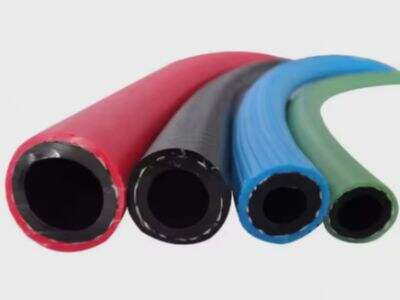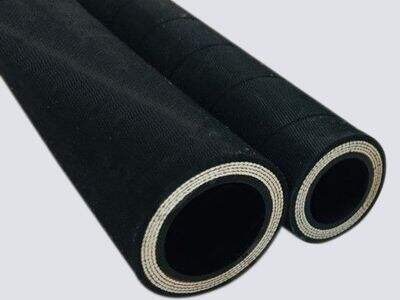There are many rubber hoses in factories and machines. When these hoses are installed the wrong way, they can fail or stop working soon. This is trouble, and it costs money. Eastop is no stranger to getting rubber hoses installed properly so they don’t die early. There are a few things that people tend to do wrong when it comes to fitting rubber hoses and also, buying the right kind of high quality hoses from the right place is important. To ensure your machines are running smoothly, it can be very beneficial to learn to prevent these mistakes and find some good hoses
How to recognise and prevent common errors when installing a rubber hose
Often people do not look at the hose size when installing. Think about how difficult, say, you would have with a big hose in place of a small one, or the other way around. This creates a leak or the hose can even burst from being under too much pressure. Other times the hoses are bent excessively or twisted during installation. This is a big problem because rubber hoses hate sharp bends. It will wear out fast and could crack if the hose is bent like a sharp corner. Additionally, some installation crews do not clean the connectors nor hose ends prior to assembling. Dirt or rust can get inside and prevent the hose from sealing correctly, allowing leaks. Another error is using wrong clamps or over-tightening them. A clamp that is too tight will bite into the rubber and create a hole, while one too loose will let fluid leak out. At Eastop, we always advise our customers to measure carefully, avoid sharp bends, clean all parts before using hoses and use the proper clamps with a good tightness

Where to Get Quality Rubber Hose Products for Bulk Purchase
It is not easy to find good quality rubber hoses in large quantities. Cheap hoses will save you some money initially but guaranteed failure within 12 months. Eastop quality rubber hoses are filled with the strength, durability, and long service life of our comprehensive line of products. Buying in bulk, it is also smart to work with companies that speak the industry language and know factory needs. Eastop provides hoses that are safe and reliable, such as those that can pump up to 500 psi, handle heat and other elements. We also ensure that each hose endures rigorous inspection before shipping. Eastop has a good stock and arranges the fast shippment to customer so that people can get what they want in time. Go for Hoses of Standard Sizes and Types When you are buying in bulk then it would be useful to have hoses that come in standard sizes and types so you don’t face confusion later. Everything Eastop sells is well labeled and comes with splash sheets on how to install and use them properly. It encourages workers to do the job properly. Even companies that buy hoses sometimes forget that support and advice during installation is essential. Eastop stand by all orders and offer technical support to clients. This support minimizes errors and loss of hose. Finally, you will take on less risk if your supplier has experience. Eastop has years of experience manufacturing and selling rubber hoses used in a variety of applications. We know what does and doesn’t work. Customers have confidence because they receive products that are ready to work and will last. Ordering from Eastop is choosing quality, successful and assistance if you need it
What Are the Top Tips for Preserving Rubber Hose Integrity in Industrial Applications
Rubber Hose is an essential item for many industries, and it’s very much in demand because of the importance that we give to rubber. In order to preserve the working state of these hoses and prevent them from breaking or leaking, it is crucial to care for them properly. The best approach to maintain strong rubber hoses is to inspect them regularly for signs of wear and damage. That means checking for any cracks, hard spots or soft areas that could indicate the hose is aging or damaged. If you note any issues early on, a hose can be replaced before it breaks and creates larger problems
Also, it is crucial to clean the hoses thoroughly. Dirt, dust and chemicals can adhere to the outside or inside of the hose, weakening its strength. Keeping the hose safe and avoiding damage by flushing with clear water or a compatible cleaning solution. And when not in use, remember to store your hoses in a cool, dry location. In so doing, heat and sunlight can cause rubber to dry out and crack more quickly
At eastop brand, we get that and we want to help! While you’re shopping for a new hose, don’t forget some of the basics about hose maintenance. Eastop recommends following these good habits because they’ll help keep rubber hoses working longer and safer. When hoses are well-maintained, companies avoid spending extra money to replace them all the time. And it helps avert accidents due to hose failure. Simple Birds-eye View Of Rubber Hose Maintenance Regular Inspections Regular inspections of rubber hoses are an essential step in the preventive maintenance process
How to Enhance Rubber Hose Performance and Durability
The fact that rubber hoses last longer and perform better is extremely important for those in industries where the hoses are used every day. Selecting the correct hose for the job is also one of the easiest ways to enhance hose performance. Rubber hoses come in a wide range of styles and materials. Some are designed for carrying hot liquids while others are suited to chemicals or air. By the proper hose, I mean it will withstand the pressure, heat and chemicals that it encounters without breaking down too much
Eastop hoses are constructed of high quality materials and the reinforced wire for the marathon hose gives you the same power without sacrificing flexibility or ease to use. But the best hose in the world won’t last long without a little tender, loving care. There are a few things that can be done to help hoses perform better, and one of them is keeping them away from sharp edges and surfaces. The hoses will wear faster if they rub up against hard or sharp objects. If you use protective sleeves or covers, this damage can be prevented and your hoses will last longer
One other method of increasing the life of hoses is by not allowing them to be subjected to extreme temperatures for long periods. Rubber is damaged equally by extremely hot and cold temperatures. Selecting hoses that can withstand heat as well if hoses need to operate in hot temperatures. Eastop manufactures some hoses specifically for these harsh conditions to assist clients in achieving quality results
You also need to periodically test the pressure of the hose. If the pressure becomes too high, it can burst the hose. Pressure regulators and safety devices help maintain safe pressure. Hoses used within its limit will last longer
Lastly, training employees on how to properly use and handle hoses can make a big impact. Commonsense things, like not dragging hoses on the ground or pulling too hard and causing damage. Eastop provides customers with hose products that are supplied with clear and concise instructions and advice, the goal being for users to know exactly what they? By selecting the right hoses to protect against wear and tear, monitoring temperatures and pressures to extend lifespan, and deploying hoses more attentively, businesses can enhance hose performance, helping them last significantly longer than anticipated

Which are the Rubber Hose Specifications That Need to be Premised to Minimize Installation Failures
Specifications are really important when installing rubber hoses to prevent failures. Specifications would be sort of like the rules or details that help us understand how strong or flexible a hose is, and what it can carry. Hoses that do meet these requirements help ensure they fit right, operate safely and last awhile
One key factor is the pressure rating of the hose. This indicates the amount of pressure a hose can safely handle. If a hose is rated at a higher pressure than it can handle, for instance, it might burst or leak. Eastop hoses have clear pressure ratings which mean that the user has no doubt as to what’s a safe pressure level is. Always choose a hose with a higher pressure rating than the maximum pressure in the system to be on the safe side
There is also the temperature. Too much heat causes rubber hoses to soften; too little, and they harden. A hose that can withstand the temperature in your work environment prevents cracking or leaking. Eastop offers hoses in various temperature ratings to handle a wide range of tasks
The hose size is also critical. A hose that is too small can lead to pressure drops and make the system work harder, while one that’s too large might be challenging to fit and maneuver. Careful measurement of the diameter and length before installation can avoid such issues
Connector flexibility and bending radius are other important considerations. Hoses have to be bent so that they can go around corners or fit in tight spaces, but if you bend them too much, they can become damaged. Specifications frequently list the minimum bend radius, which indicates to what degree a hose can be bent without damage. This rule will help to ensure hoses are safe during installation
Finally, the cover and tube materials of a hose also impact how resistant it is to chemicals, abrasion and weather. For example, Eastop carefully selects the material to be used so that it addresses the specific requirements for several industries, which all help avoid failures due to material wear
A focus on these key details, pressure rating, temperature range, size and flexibility, as well as materials of construction, helps streamline the selection process for those who install hose and lessen the likelihood that it will fail. Eastop are one of the UK’s leading hose and fittings suppliers offering excellent product quality, service and value for money
Table of Contents
- How to recognise and prevent common errors when installing a rubber hose
- Where to Get Quality Rubber Hose Products for Bulk Purchase
- What Are the Top Tips for Preserving Rubber Hose Integrity in Industrial Applications
- How to Enhance Rubber Hose Performance and Durability
- Which are the Rubber Hose Specifications That Need to be Premised to Minimize Installation Failures

 EN
EN
 AR
AR
 BG
BG
 HR
HR
 CS
CS
 DA
DA
 NL
NL
 FR
FR
 DE
DE
 IT
IT
 PT
PT
 RO
RO
 RU
RU
 ES
ES
 TL
TL
 ID
ID
 VI
VI
 HU
HU
 TH
TH
 MS
MS
 BN
BN

